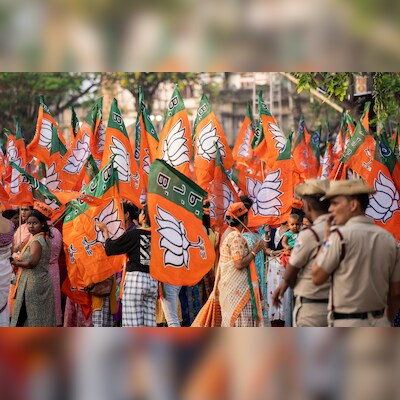[ad_1]
The Bharatiya Janata Party’s (BJP) election manifesto seems to have resonated with the electorate in Haryana despite critics voicing concerns over discontent among the crucial voter demographics, including farmers, youth, and soldiers.
With 20 promises on the table, the party cast net wide, addressing a diverse array of needs. Key among their promises is to purchase 24 crops at a guaranteed minimum support price (MSP) and ensure government jobs for every Agniveer, which cater to farmers and soldiers. Laado Laxmi Yojana is projected to empower women by providing Rs 2,100 monthly to eligible recipients.
Healthcare also takes the centre stage, with the Chirayu-Ayushman Yojana offering free medical treatment up to Rs 1 million for families, besides Rs 500,000 for seniors over 70 years. The Har Ghar Grihani Yojana promises affordable LPG cylinders at Rs 500, while the Awal Balika Yojana will support female college students in rural areas by providing scooters to enhance their mobility and access to education.

As the BJP navigates through these expectations, it’s essential to examine Haryana’s fiscal health to gauge how effectively these commitments can be fulfilled. The state’s capacity to generate its own tax revenue is promising, with an estimated 72.5 per cent of total revenue receipts projected to come from this head — significantly higher than the average of other states at 49.2 per cent for 2023-24.
While tax revenues show promise, around 60 per cent of estimated revenue receipts are committed to existing expenditures, including salaries and pensions, limiting the flexibility to fund new initiatives. In terms of infrastructure, the BJP has pledged to build 10 industrial cities, expected to create jobs for 50,000 locals each, alongside the construction of the Kundli-Manesar-Palwal Orbital Rail Corridor and the launch of new Vande Bharat trains in collaboration with the central government. Yet, there’s a projected decline in capital outlay from Rs 17,666 crore in FY20 to Rs 16,821 crore in FY25, raising questions about the viability of these ambitious plans.
Though recent data from the Periodic Labour Force Survey (PLFS) shows a decline in the unemployment rate from 6.1 per cent in 2022-23 (July-June) in the state to 3.4 per cent in 2023-24, slightly above the national average. This does not fully address the challenges faced by graduates and postgraduates.
These segments experienced unemployment rates of 6.6 per cent and 7.5 per cent, respectively in 2023-24.

First Published: Oct 09 2024 | 12:32 AM IS
[ad_2]
Source link

